On 17 August 1850, Harrison Ramsey sold property to Joel Curtis in Clinton County, Illinois.
The northwest quarter of section thirty in township three north of range west contains 153.43 acres according to the legal description of the deed. Harrison Ramsey is the only grantor on the deed. Curtis is the only grantee on the deed. Harrison is styled as being of Clinton County and Curtis is styled as being of Madison County. The deed itself is boilerplate text with the names, consideration, and legal description included where appropriate.
It is the acknowledgement of the deed that is somewhat atypical. It is dated 16 August 1850 and was made out before Joseph Duncan, Justice of the Peace in Madison County, Illinois.

One difficulty here is that I’m not looking at the actual deed. I’m looking at the record copy–a transcription made by the local county recorder in Clinton County. The clerk copied what was on the actual deed.
The actual deed–the original signed by Harrison Ramsey which would have contained the actual signature of the Justice of the Peace as well–was returned to Joel Curtis (the buyer) after it had been recorded. The actual deed was either written entirely free hand on a blank sheet of paper or was created by filling in blanks on a legal form. The forms were readily available by 1850 and facilitated the creation and the recording of deeds by standardizing them. But there’s no way of knowing if this deed was originally written on a pre-printed form or on a blank. A form may have included the acknowledgement–for the individual writing out the deed to complete.
There may have been no wife and the person making out the deed simply forgot to cross-out the part of the form that did not apply. The clerk would have to record what was written on the deed–whether it looked incomplete or not. The clerk’s job was to copy as is.
Or the acknowledgment may have been written while the deed was being drawn up and that the wife would be there to acknowledge it and the deed was not recorded on a form at all. Although it does seem odd that the writer of the original deed would not have the wife’s name–but it’s possible that the deed was drawn up by someone who knew the buyer (given that they both resided in Madison County), but did not know the name of the wife.
The most likely person who “made out” the deed was the Justice of the Peace since it was acknowledged by Harrison before him on the same day it was signed.
Then there is the fact that the wife is not mentioned in the grantor section of the deed. During this time period in Illinois, if there the grantor had a wife (even if her name is not on the deed of acquisition) she usually appeared as a grantor as she would have had to release her interest in the property as the seller’s wife.
Does this mean Harrison had a wife at the time the deed was drawn up?
Or was he single at the time the deed was drawn up?
Was the inclusion of the “blank” wife acknowledgement an error? Was it because the wife refused to sign (if there was one)?
All I know is what the deed says and that there’s more work to do.

No responses yet